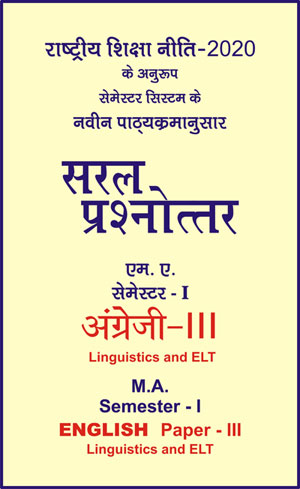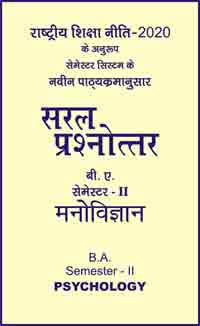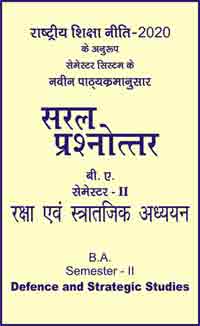|
बी ए - एम ए >> एम ए सेमेस्टर-1 - अंग्रेजी - तृतीय प्रश्नपत्र - लिंग्विस्टिक्स एम ए सेमेस्टर-1 - अंग्रेजी - तृतीय प्रश्नपत्र - लिंग्विस्टिक्ससरल प्रश्नोत्तर समूह
|
5 पाठक हैं |
|||||||
MA Semester-1 English Paper-III - Linguistics and ELT
Eclectic Method
Question- What is Eclectic method (approach) of language learning/ teaching?
Or
What is salient features of the Eclectic Approach?
Answer -
Eclectic approach is a method of language learning/teaching that com- bines various approaches and methodologies to teach languages depending on the aims of the lesson and the abilities of the learners in this approach teacher has more flexibility and adaptability to choose best elements ac- cording to the need and aim of the students. Different teaching methods are borrowed and adapted to suit the requirement of the learners, it breaks the monotony of the class.
The main purpose here is to create a new method made of all the various methods already existed and incorporated in ELT, taking the advan- tage of each method, approach and technique. In fact, the main idea is to use all the available methods. The Eclectic approach is the one of that integrates all the language - teaching methods depending on the classroom circumstances and the abilities of the learners.
The eclectic approach was advocates as almost all the individual methods had their strengths and weakness and not even a single method was responsible to the real and dynamic classroom context. Taking the draw- backs of the various methods into consideration, Brown (2002) argues that electicism finds the right solution as this approach permits the teacher to select what works well in their classrooms with their own dynamic contexts. Even Gilliland, James and Bowman (1994) declared that the justification to adapt the Eclectic approach lies in the single method or approach because a single method or approach has a narrow theoretical basis and has a fixed set of activities and hence it is inflexible.
Salient features of the Eclectic Approach - The Eclectic approach is regarded as one of the best approaches in ELT. Teachers will be successful in teaching if they implement this approach in English language classroom. Examine the salient features of Eclectic approach -
(1) Eclectic approach (EA) makes teaching innovative and enjoyable. The learning objectives are easily achieved.
(2) The learners participates in a lesson actively and interacts with teacher and other students.
(3) E.A. brings capabilities among the students and children's for individual needs.
(4) The E.A. makes the teaching of English practical as it facilitate retention and build confidence in language learners.
(5) This approach enables teachers attain the objectivies of learning easily as the learners understand the concepts and acquire knowledge be- cause learning becomes fun and innovative.
(6) It further strengthens effective learning of English as more infor- mation of knowledge is retained for a long time that enables learners to speak fluently and perform grammatically.
(7) Depending on the aims and objectivities of the lesson and the learners in the group, the teacher decides what methodology or approach to use.
(8) It's problem based approach to teaching language that solves the problem faced by the learners in the classroom.
(9) Testing is a part of this method and not a separate entity.
(10) Teacher attain good result without much pressure on the learner.
(11) The features of this method include multiple tasks, lively learn- ing high interaction, objectives correlative and fast results.
(12) This approach connects life experiences to the ideas presented in learning the language.
(13) E.A. supports natural order of learning first listening, followed by speech and then reading and writing.
(14) The students should be active learners instead of being more recipients of information.
(15) Teacher should act as facilitators and provide opportunities for students to express their ideas, without any fear in English.
(16) Activities and resources should be adopted as much as possible to use English in natural contexts.
(17) Various activities are introduced in the English classroom by using the innovative technology available.
(18) There is flexibility for teachers to choose any method or approach that suitable for teaching inside the classroom.
(19) E.A. saves both time and effort in the presentation of language activities.
(20) The teacher proposes a variety of excercises, both written and oral, in order to improve the learners, communicative abilities with acuracy and fluency.
(21) E.A. focuses on motivation and learner antonomy, selecting tech- niques based on the learner and context.
(22) The Eclectic approach is the juxtaposition both the inductive and deductive strategy to teaching language.
(23) The concept of the Eclectic approach is that learners learn not only from teachers but also from fellow learners by working together or as a group.
Thus the salient features of Eclectic approach are discussed thor- oughly and in a comprehensive way.
|
|||||
- Question- Describe the place of English language in India.
- Question- Explain the term 'language'.
- Question- Define Language.
- Question- Write a note on Origin and development of Human language.
- Question- What is the meaning of language origins?
- Question- When did language come into existence?
- Question- What are the different theories of the origin of language?
- Question- What are the approaches to understanding the Evolution of language?
- Question- Is there any historical record of the development of human language?
- Question- What are the properties of Human Language?
- Question- What are the characteristics of human language?
- Question- What are the benefits of studying linguistics?
- Question- What are the six properties of language?
- Question- What are the properties of human language for Charles Hockett?
- Question- What is the meaning of Linguistic as science?
- Question- What is the science of linguistics?
- Question- What is scientific method in linguistics?
- Question- What is difference between philology and linguistics?
- Question- Why is linguistics a science?
- Question- What are the examples of science linguistics?
- Question- What are linguistic models in linguistics?
- Question- What are linguistic models in linguistics?
- Question- What is linguistic analysis?
- Question- What is the difference between statements in fact models and linguistic models?
- Question- What is the importance of linguistic analysis?
- Question- Is linguistic analysis meaningful meaning possible?
- Question- What is the drive or purpose behind linguistic analysis?
- Question- What is it called, when we study the study of language?
- Question- What is communication? What are different functions of communication?
- Question- Define the communication process with diagram.
- Question- Write a note on classification of the communication.
- Question- How does the need to communicate affect the development of language?
- Question- What is the role of English Language in Communication?
- Question- What is language in human communication?
- Question- What is the purpose of multiple uses of language?
- Question- What is difference between formal and informal communication?
- Question- What do you understand by Phonemes?
- Question- Define Phonology. In what respects does it differ from general phonetics?
- Question- Write a note on basic concept of phoneme.
- Question- What do you understand by Phonology? What is the difference between Phonetics and Phonology?
- Question- How do you classify English vowels according to the part of the tongue used during their articulation?
- Question- What is Consonant? What do you know about Contoids and Vocoids?
- Question- What are semi-vowels and how are they produced?
- Question- Write a note on Vowels.
- Question- What is Generative phonology?
- Question- We can divide the sound system into two parts. Name them.
- Question- What is the importance of stress in speaking a language?
- Question- Write a note on the functions of Intonation.
- Question- What is intonation? Types of intonation in spoken English.
- Question- What is attitudinal intonation and how to improve it?
- Question- Write a note on Stress.
- Question- Write a note on the levels of Stress.
- Question- What is Lexical Stress or Word Stress?
- Question- What is intonation and how does it works?
- Question- What is manner of Articulation?
- Question- What is place of articulation?
- Question- What is phonetic transcription? What is the difference between phonetic transcription and phonemic transcription?
- Question- Provide the phonetic transcripts of the following English words : (a) Keen (b) Measure (c) Noon (d) Share
- Question- Fill in the blanks with correct vowels.
- Question- What is phonetic transcription?
- Question- How do you transcribe phonemes in English?
- Question- What is syllable?
- Question- How many types of syllable in English?
- Question- What is an open syllable?
- Question- What is closed syllable?
- Question- What is morpheme in English Grammar?
- Question- What is the difference between free morphemes and affixes?
- Question- Why are morphemes considered open class words?
- Question- What is a zero-morpheme?
- Question- What is the difference between free and bound morphemes?
- Question- What is difference between compound and complex morphemes?
- Question- What are lexical morphemes?
- Question- What is the meaning of word and word classes?
- Question- What is the grammar of word classes?
- Question- What is an example of a word class?
- Question- What are word classes and why are they important?
- Question- Can a word belong to more than one word?
- Question- What is inflection in grammar?
- Question- What are the different forms of inflection?
- Question- What are inflection suffixes?
- Question- Write a definition of inflection. What are the eight inflections?
- Question- What are the five types of inflections?
- Question- What is inflection in communication?
- Question- What is derivation in English?
- Question- What are the rules of word formation and derivation?
- Question- What is the difference between derivation and infection?
- Question- What is compounding in linguistics with example?
- Question- What is compounding word formation examples?
- Question- What is compounding in English?
- Question- What is compounding in morphology and its types?
- Question- What are the three types of compounding?
- Question- What is the difference between compounding and blending words?
- Question- What is the difference between derivation and compounding?
- Question- What is categories and constituents in linguistic?
- Question- What are examples of constituents?
- Question- What does category mean in linguistics?
- Question- What are two syntactic categories?
- Question- What are the categories of english?
- Question- What are examples of Semantics?
- Question- What is the meaning of Predicate and Argument structure?
- Question- What is the difference between predicate and argument?
- Question- What is argument structure in semantics?
- Question- What is predicate in semantics?
- Question- What are the seven sentence structure?
- Question- What is sentence structure called?
- Question- What is the meaning of thematic roles in semantic analysis?
- Question- What is meant by thematic roles?
- Question- What is thematic role in a story?
- Question- Why are thematic roles important?
- Question- What is theme in semantic roles with examples?
- Question- Define case or what is case in syntax?
- Question- What is a case in syntax?
- Question- What is case grammar how syntactic and semantic can be combined?
- Question- What are semantic cases?
- Question- What is Phrase structure grammar?
- Question- What is the role of phrase-structure grammar?
- Question- What is phrase and types?
- Question- What are examples of phrases?
- Question- What is the meaning of lexical semantics and what is the relation and how meanings relate to each other?
- Question- What is lexical relation and example?
- Question- What are the sex lexical relations?
- Question- What is the meaning of lexical?
- Question- Why lexical relations are used in language?
- Question- What is implicative or implication function?
- Question- What is the symbol of implicative function?
- Question- What are two parts of an implication called?
- Question- What is the use of logical implication?
- Question- Explain the meaning of entailment and presupposition with examples.
- Question- What is difference between presupposition and entailment?
- Question- What are the types of entailment?
- Question- What are the types of presuppositions?
- Question- Why is entailment important?
- Question- What is the maxims of conversation?
- Question- What are maxims of conversation mean?
- Question- What is maxim of manner example?
- Question- What is the purpose of maxims?
- Question- What is the difference between maxim and aphorism?
- Question- What is speech act, explain it with example?
- Question- What is performative speech act?
- Question- What are the five functions of speech act?
- Question- What is the importance of speech act in our daily?
- Question- What is the meaning of speech act theory?
- Question- What is indirect speech acts?
- Question- What is the nature and application of psycholinguistics? Explain it with examples.
- Question- What is psycholinguistics?
- Question- What are the issues and areas of research in psycholinguistics?
- Question- What are the branches of psycholinguistics?
- Question- How many discipline are there in psycholinguistics?
- Question- What are the main objective of psycholinguistics?
- Question- What are the behaviourist theory of language learning?
- Question- What are the cognitive and mentalist views of language learning?
- Question- What is the difference between behaviourist and mentalist?
- Question- What are the three theories of language learning?
- Question- What are the three behavioural theories?
- Question- What is the cognitive theory of language development?
- Question- How are behaviourism and mentalist different in their views about learning?
- Question- What do you mean by individual differences in language learning? Explain with examples.
- Question- How does individual differences affect language learning?
- Question- Why is individual differences important in teaching and learning?
- Question- How do you apply individual differences in learning?
- Question- What is individual differences in learning?
- Question- What are the consequences of individual differences?
- Composition
- Parts of Speech
- Active Voice and Passive Voice
- Direct and Indirect Speech
- Tenses
- Synonyms
- Antonyms
- Question- Write the antonym of the following - (i) Changeable (ii) Deep (iii) Drave (iv) Include (v) Refuse (vi) Exactly
- Question- Translation from Hindi to English :
- Question- Translation from English to Hindi.
- Types of Sentences
- Idioms and Phrases
- Proverbs
- Letter Writing
- Question- Respond to an advertisement for the post of lecturer in a local college and supply details from your imagination.
- Question- Make an application to the Principal P. P. N. College Kanpur for giving you a full concession in fee..
- Question- Write an application to the Principal of your college requesting him to allow you to change one of your subjects.
- Question- Write an Application for the post of a Stenographer-cum accountant in a local bank.
- Question- Write an application to the District Supply Officer for supplying building material.
- Question- Write an application to the Principal of your college requesting him to grant you leave for four days so that you may attend the marriage ceremony of your elder sister.
- Write an application to the Principal of your college requesting him to make arrangements for a separate common room for girls in the college.
- Question- Write a letter to your younger brother advising him how to prepare for the Examinations.
- Question- Write a letter to your younger brother advising him to pay atten- tion to his studies and not to waste his time in the company of idle friends.
- Write a letter to the principal of the school for arranging reme dial class for English.
- Bussiness Letters
- Chief characteristics of a good application for employment
- Question- Write an application letter for the post of "Juniour Accountant Trainee" in the Vyasa Bank Ltd. New Delhi, addressing to the Personnel Manager.
- Question- Write popular and compact form of general purpose resume.
- Question- Write a Comprehensive Resume with its covering letter.
- Story Writing
- Question- Write a short story on 'Tit for Tat' in about 500 words.
- Question- Write a short story in about 500 words on 'where there's a will, there's a way.
- Question- Write an essay on The Menace of Terrorism.
- Question- Write an essay on Pollution.
- Question- Write an essay on Importance of Computer.
- Dialouge Writing
- Picture Composition
- Question- Answer in English the following questions on the above passage -
- Question- Choose the best answer out of the possible answers given.
- Question- Fill in the blanks below using suitable words taken from the list- (independence, control, powers, account, active, system, universal, strict.)
- Question- Choose the best answer out of the possible answers given-
- Question- Use suitable words from the list given below to fill in the blanks - (forgive, respect, scenery, truth, pleasure, err, speech, neglect, liberty, silence)
- Figure of Speech
- Precis Writing
- Paraphrasing
- Question- Grammar should be taught functionally at the lower classes and formally in the higher classes? Explain with concrete il lustrations.
- Question- What are the aims of teaching English Grammar?
- Question- What are the factors that influence language learning for students?
- Question- What are the factors that affect English language acquisition?
- Question- How do external factors effect English language learning?
- Question- What makes a language learner successful?
- Question- What are the external factors of English language learning?
- Question- Which factors impact the learning curve of English-Language learners?
- Question- Direct method ensures fluency, grammar translation method ensures accuracy but bilingual method ensures both discuss.
- Question- What do you understand by Billingual Method Ensure both Fluency and Accuracy?
- Question- Discuss merits and demerits of Direct Method of teaching English?
- Question- Show in what ways Direct Method is improvement over Translation cum-Grammar Method. How can a teacher effectively use it?
- Question- "Structural approach is the foundation upon which the study of English teaching should develop." Discuss.
- Question- What do you understand by situational approach to teaching English?
- Question- What do you understand by structural approach of teaching English?
- Question- What are the objectives of structural approach?
- Question- State the principles of structural approach.
- Question- What is the process of adopting structural approach?
- Question- Describe the merits of structural approach.
- Question- How will you make use of structural approach in teaching the students of sixth class?
- Question- Discuss in detail the inductive- Deductive method of teaching English grammar with appropriate example.
- Question- Write down the aims of teaching translation at school level.
- Question- Write a note on Translation Method.
- Question- What do you mean by inductive-deductive method for teaching of grammar?
- Question- Discuss Dr. Michael west's new method.
- Question- Discuss communicative approach of teaching.
- Question- Describe the demerits of Grammar-translation method.
- Question- Differentiate between approach and method of teaching.
- Question- Write a short note on bilingual method of English teaching.
- Question- Explain the main characteristics of Bilingual method of teaching English?
- Question- Discuss communicative approach of teaching.
- Question- What is Eclectic method (approach) of language learning/ teaching?
- Question- What are the advantages and disadvantages of Eclectic Approach?
- Question- What is the eclectic approach to teaching English?
- Question- What are the activities of eclectic method?
- Question- What is a notional-functional syllabus?
- Question- What are the theories of notional functional syllabus?
- Question- What is notional functional syllabus theory?
- Question- What is the notional functional movement in linguistics?
- Question- What is the silent way language Teaching approach?
- Question- What are the aims/goals of silent way of teaching approach?
- Question- What are the characteristics of silent way of teaching?
- Question- What are the roles of teacher and learner in silent way of teaching?
- Question- Define audio-visual aids. What is the need of these aids in the teaching of English?
- Question- Give definitions of audio-visual aids.
- Question- What are the needs/importance of audio-visual aids in teaching of English?
- Question- State some use of audio-visual aids for teaching English.
- Question- What is the importance of Black-Board in teaching of English?
- Question- What are the advantages of maps as a support material?
- Question- Comment on Projector.
- Question- State the objectives and role of language laboratory in teaching of English.
- Question- What is contrastive analyses?
- Question- How many types of errors in English language teaching?
- Question- What are the stages of Error Analysis?
- Question- What are the distinctions between mistakes and errors?
- Question- What is test and testing? Explain it.
- Question- What is the meaning of evaluation?
- Question- What is test, testing and evaluation?
- Question- What is the difference between test and testing?
- Question- What is evaluation testing important?
- Question- What is the purpose of testing?
- Question- What are the characteristics of a good test?
- Question- What is language planning and its types?
- Question- What are the stages of language planning?
- Question- What are the principles of language planning?
- Question- What is language planning and why is it important?
- Question- What is language planning in education?
- Question- What are the factors influencing language planning?
- Question- What is the difference between language planning and language policy?
- Question- What do you understand by lesson plan? Discuss its characteristics and approch to write it.
- Question- What would be the characteristics of a good lesson plan?
- Question- Discuss any approach of lesson planning.
- Question- List the various steps of lesson planning based on Herbartain approach.
- Question- 'Nothing is so fatal for a teacher as unpreparedness.' Discuss the need of lesson planning in the light of this statement.
- Question- Prepare a lesson plan of either prose or poetry or grammar or compostion on a topic of your own choice.
- Question- What are the possible learning outcomes in english primary stage according to the NCERT approach?
- Question- Give the outline of Herbartian Lesson Plan Format.
- Question- What are the advantages of Herbartian Lesson Plan?
- Question- What are the limitations of Herbartian Lesson Plan?
- Question- What are the important characteristics of a good lesson plan in Herbartian approach?
- Question- Enumnerate the term 'curriculum'. Which procedures are used for curriculum organisation?
- Question- Discuss various procedures of curriculum organisation.
- Question- Explain the topical approach of organization of curriculum.
- Question- Indicate the meaning of integrated approach to English cur- riculum organization.
- Question- Draw a structure of curriculum of English at various levels. The answer to this question is completed by consolidating the answers to the following related questions..
- Question- Suggest curriculum of English for secondary classes.
- Question- Give four drawbacks of existing curriculum of English.
- Question- Give a critical appraisal of existing Syllabus in English?
- Question- Describe the place of English language in India.
- Question- Discuss the place of English after independence.
- Question- Describe the place of English in present days.
- Question- Discuss the importance of English language in India.
- Question- Which language was termed as language of communication in India?
- Question- Why and when English is declared as an official language of Administration?
- Question- How did English open the gates of Western Sciences and Arts to Indians?
- Question- Explain importance suggested by different commissions about English language.
- Question- Explain the influence of English in education.
- Question- What is the role of English for Literary Development?
- Question- Why English is also called an International Language?
- Question- State effect of English in social life.
- Question- "English ensures Unity of India." How?
- Question- Explain the meaning of ecolonization and what its impact on english literature to literatures in english?
- Question- What is decolonization and why is it important?
- Question- Can pre-colonial cultures be recovered by decolonization?
- Question- What are the problems of teaching English in India?
- Question- What are the solutions for the problems faced by teacher's in Teaching English language?
- Question- What are the problems of teaching the English language?
- Question- What are the major obstacles in teaching English to students?
- Question- What is the basic need of teaching the English language?
- Question- What are the problems of teaching the English language?
- Question- What is "Register" and what it is use?
- Question- What are the types of register in English?
- Question- What is Diatype?
- Question- What is register in language?
- Question- What is a register style?
- Question- What is the function of registers?
- Question- What is Register classification in the OED?
- Question- Explain the role of English in India.
- Question- Enumerate the Nature of English Language.
- Question- What is english as a second language (ESOL).
- Question- Why is English the most popular second language?














